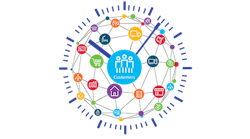The Customer Is Always Right Now
Traditional supply chain planning and execution, based on a static network definition, is reaching its end of life. Whether related to the omni-channel explosion or the sharing economy, the customer’s grip on the point-of-sale (POS) is disrupting the status quo, prompting many vigilant companies to rethink and strategize how they go to market. Such companies have been successful in capitalizing on e-commerce and delivering personalized services to consumers. This is in part due to early recognition and separation of their business-to-consumer (B2C) and business-to-business (B2B) models, as well as the fact that B2B customers have started exhibiting purchasing expectations similar to B2C customers.
Interestingly, along with this paradigm shift, has come a new business model defined entirely around customer-centricity. The model, focused on the “new consumer” whose sense of urgency is now, has redefined segmented supply chain planning as we know it. Much has been written about how the consumer’s desire for timeliness (think product availability and delivery) has influenced, and will continue to influence, supply chain operations. In fact, the “new consumer” impact has been so noteworthy that the business model could very well be named “B2Me-Now.”
It All Ties Back to the Customer
The transition to this B2Me-Now environment has been driven by a significant change in how customers approach purchasing decisions. Today, decisions are often made and/or socially influenced on-the-fly, and are therefore not always a true reflection of the historical past. Customers’ decisions are increasingly influenced by the price-competitiveness of the offer, the desire for a seamless and similar experience across all channels, an easy purchasing and return process, and most importantly, the ability to personalize the product—and have it delivered now.
Additionally, the customer’s expectation for real-time visibility into the order lifecycle is soon to become a table stake. Armed with smart gadgets, customers want to know at all times when their purchases are expected to ship, where they are in transit and when delivery is promised. By offering customers cross-channel purchasing and delivery flexibility, the point-of-purchase and point-of-consumption are often not the same. This extreme focus on customer-centricity warrants a game-changing approach to sensing and responding to customers’ needs.
This new uber-consumerism will require the upstream supply chain network to be flexible, fast and profitably responsive. Companies that continue to rely on traditional approaches to supply chain planning and execution will fail.
A Flexible, Fast and Responsive Supply Chain
To better serve this B2Me-Now consumer, companies need to move away from the traditional bi-linear supply chain model and adopt a multi-dimensional supply chain grid model. This grid-based approach adapts traditional planning and execution constructs to better sense and respond to ever-shrinking lead times across the value network. To accomplish this, the traditional enterprise supply chain network can no longer be defined by static connections. Instead, it must be replaced with a dynamic network that can evolve with time and interface with the Internet of Things and emerging digital technologies. This supports real-time sensing and real-time responses, forming the foundation for informed, rapid and optimal—as well as profitable—decisions.
The B2Me-Now model also requires adaptable supply chain processes to meet the personalized point-of-purchase, consumption and return needs of today’s customers. E-commerce has ushered in many changes in this area; it is no longer uncommon for the POS, consumption and return to span different coordinates across the globe. For instance, a customer could purchase a tablet online in India, but want it shipped to Thailand and might decide to return it, or have it serviced, while traveling in Texas. Companies can no longer rely solely on past localized purchasing activity to predict future purchases, consumption and returns.
The Demand Planning Process Redefined
The fundamental challenge now lies in how companies should direct their demand-sensing activities. Should it be focused on the product that is being bought, the attributes of the product (such as color, size, etc.), the purchaser, the region of consumption, or the price point of the product? This challenge goes beyond traditional forecasting methods; the process calls for additional artificial intelligence to sense and predict future demand across a continuous spectrum, potentially looking past purchasing history to include an increasing number of unstructured data inputs that could shape and enhance the near-term and short-term forecast.
In this case, both data and time become critical supply chain components, spurring the transition from structured and static constraint-based planning to an agile, “always-on” and responsive B2Me-Now model. Additionally, the physical supply chain network, often characterized by asset-heavy and capital-intensive investments such as manufacturing plants, contractual labor, spacious warehouses and fleet vehicles, can no longer be rigid if it is to support real-time decisions.
Any changes to the POS or point-of-consumption will create a ripple effect upstream. Thanks to the prevalence of mobile devices, apps and widely available connectivity, the POS is no longer static. The ability to consume products or services more flexibly, without judgment or undue influence, has become dramatically easier. Upstream partners will now have to account for the new risks and opportunities introduced by this phenomenon and respond to them more quickly.
New Levels of Collaboration
High-speed, widely available Internet, cloud applications and mobile devices enable previously unconceived groups of products and services to be developed and offered. But there’s little value in an idea or product if the customer can’t receive it when and where they want it, and this requires an effective and flexible supply chain. New levels of collaboration and visibility are needed, and can be implemented as companies adopt a more mature, always-on supply chain mindset. For instance:
• A traditional supply chain consists of interdependent organizations involved in the flow and transportation of goods and services from the point-of-origin to delivery to the end customer. Those supply chain partners must collaborate to plan and control the flow of goods and services to meet customer requirements. This calls for transparency to be established with both sell-side and buy-side trading partners.
• A more progressive, collaborative supply chain seeks to coordinate among and across its members to produce and distribute products at the lowest overall costs while still satisfying customer demand. While this may sound like an age-old collaborative planning, forecasting and replenishment (CPFR) process, it is not. The need here is for collective, joint ownership of the POS by all partners.
• At the most advanced level of collaboration, an inter-connected supply chain grid is utilized, where the related supply chain systems work together to gather, analyze and share real-time information on operations, product movement and resources from all supply chain nodes. This allows participants to order and make inventory movement decisions for a minimum overall cost, while continuously re-directing decisions based on prescriptive analytics as new data becomes available. Emerging digital technologies will have the most impact here.
The B2Me-Now business model has pushed the envelope of just-in-time collaboration, requiring the supply chain to be hyper-responsive. This can only be accomplished when organizations step away from the rigid definitions of a linear supply chain and instead adopt a flexible and adaptable supply chain grid model that is more resistant to the demand and supply swings driven by today’s consumer. After all, companies will only be successful in this B2Me-Now environment if they can meet customers where they are, with the products they expect, when promised.
Doug Kimball is senior product marketing director with JDA Software, a provider of end-to-end, integrated retail and supply chain planning and execution solutions. Srini Muthusrinivasan is JDA’s senior industry strategies director.




